
Domenico di Tommaso Curradi di Doffo Bigordi, professionally known as Domenico Ghirlandaio, was an Italian Renaissance painter born in Florence. Ghirlandaio was part of the so-called "third generation" of the Florentine Renaissance, along with Verrocchio, the Pollaiolo brothers and Sandro Botticelli. Ghirlandaio led a large and efficient workshop that included his brothers Davide Ghirlandaio and Benedetto Ghirlandaio, his brother-in-law Bastiano Mainardi from San Gimignano, and later his son Ridolfo Ghirlandaio. Many apprentices passed through Ghirlandaio's workshop, including the famous Michelangelo. His particular talent lay in his ability to posit depictions of contemporary life and portraits of contemporary people within the context of religious narratives, bringing him great popularity and many large commissions.

Filippino Lippi was an Italian painter working in Florence, Italy during the later years of the Early Renaissance and first few years of the High Renaissance.

Lorenzo Lotto was an Italian painter, draughtsman, and illustrator, traditionally placed in the Venetian school, though much of his career was spent in other north Italian cities. He painted mainly altarpieces, religious subjects and portraits. He was active during the High Renaissance and the first half of the Mannerist period, but his work maintained a generally similar High Renaissance style throughout his career, although his nervous and eccentric posings and distortions represented a transitional stage to the Florentine and Roman Mannerists.

Domenico di Michelino (1417–1491) was an Italian Renaissance painter who was born and died in Florence. His birth name was Domenico di Francesco. The patronymic "di Michelino" was adopted in honour of his teacher, the cassone painter Michelino di Benedetto, by whom no works have been identified. Giorgio Vasari reports that Domenico was also a pupil of Fra Angelico, whose influence is reflected in many of Domenico's paintings along with that of Filippo Lippi and Pesellino.

Pinturicchio, or Pintoricchio, also known as Benetto di Biagio or Sordicchio, was an Italian painter during the Renaissance. He acquired his nickname because of his small stature and he used it to sign some of his artworks that were created during the fifteenth and sixteenth centuries.

Pietro Perugino, an Italian Renaissance painter of the Umbrian school, developed some of the qualities that found classic expression in the High Renaissance. Raphael became his most famous pupil.

Francesco Francia, whose real name was Francesco Raibolini was an Italian painter, goldsmith, and medallist from Bologna, who was also director of the city mint.

The Alte Pinakothek is an art museum located in the Kunstareal area in Munich, Germany. It is one of the oldest galleries in the world and houses a significant collection of Old Master paintings. The name Alte (Old) Pinakothek refers to the time period covered by the collection—from the fourteenth to the eighteenth century. The Neue Pinakothek, re-built in 1981, covers nineteenth-century art, and Pinakothek der Moderne, opened in 2002, exhibits modern art. All three galleries are part of the Bavarian State Painting Collections, an organization of the Free state of Bavaria.

Raffaellino del Garbo (1466–1527) was a Florentine painter of the early Renaissance.

Dieric Bouts was an Early Netherlandish painter. Bouts may have studied under Rogier van der Weyden, and his work was influenced by van der Weyden and Jan van Eyck. He worked in Leuven from 1457 until his death in 1475.

Ridolfo di Domenico Bigordi, better known as Ridolfo Ghirlandaio was an Italian Renaissance painter active mainly in Florence. He was the son of Domenico Ghirlandaio.
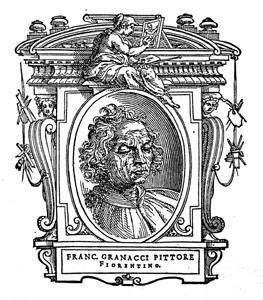
Francesco Granacci was an Italian Renaissance painter active primarily in his native Florence. Though little-known today, he was regarded in his time and is featured in Giorgio Vasari's Lives of the Artists.
The decade of the 1480s in art involved some significant events.
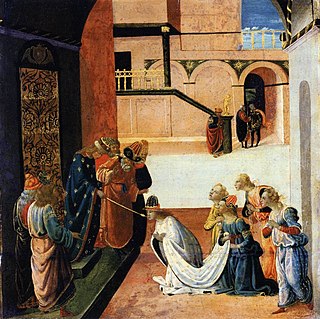
Jacopo del Sellaio (1441/42–1493), was an Italian painter of the early Renaissance, active in his native Florence. His real name was Jacopo di Arcangelo. He worked in an eclectic style based on those of Botticelli, Filippino Lippi, and Domenico Ghirlandaio. The nickname Sellaio derives from the profession of his father, a saddle maker.
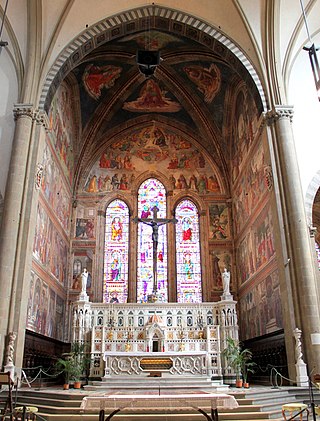
The Tornabuoni Chapel is the main chapel in the church of Santa Maria Novella, Florence, Italy. It is famous for the extensive and well-preserved fresco cycle on its walls, one of the most complete in the city, which was created by Domenico Ghirlandaio and his workshop between 1485 and 1490.
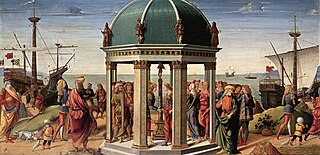
Biagio d’Antonio Tucci was an Italian Renaissance painter active in Florence, Faenza and Rome.

Bastiano di Bartolo Mainardi (1466–1513) was an Italian painter of the Early Renaissance. He was born in San Gimignano and was active there and in Florence.

A donor portrait or votive portrait is a portrait in a larger painting or other work showing the person who commissioned and paid for the image, or a member of his, or her, family. Donor portrait usually refers to the portrait or portraits of donors alone, as a section of a larger work, whereas votive portrait may often refer to a whole work of art intended as an ex-voto, including for example a Madonna, especially if the donor is very prominent. The terms are not used very consistently by art historians, as Angela Marisol Roberts points out, and may also be used for smaller religious subjects that were probably made to be retained by the commissioner rather than donated to a church.
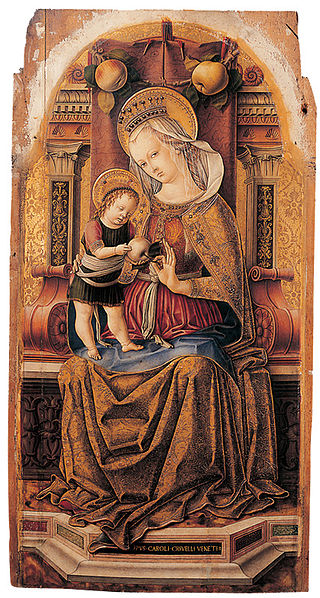
The St Peter Martyr Altarpiece or Minor San Domenico Altarpiece is a altarpiece in tempera and gold on panel by the Italian Renaissance painter Carlo Crivelli, executed c. 1476. Its central panel of the Madonna and Child, signed "OPVS CAROLI CRIVELLI VENETI", is now in the Museum of Fine Arts in Budapest. The altarpiece's other panels were seen in Rome by Luigi Lanzi in 1789 before being moved to Florence with the Rinuccini family. In 1868 it moved from the Demidov collection to the National Gallery in London, where they still hang.


















